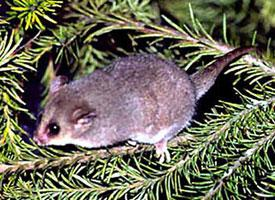
Weights and measures
| Length | from 7 to 11 cm |
|---|---|
| Weight | from 15 to 45 g |
Animal description
The Eastern Pygmy Possum (Cercartetus nanus) is a small, captivating marsupial native to southeastern Australia, including Tasmania. This diminutive creature is part of the family Burramyidae, which comprises the pygmy possums, a group known for their small size and arboreal lifestyles. Despite its name, the Eastern Pygmy Possum is not closely related to the larger possums of the Phalangeridae family but shares more similarities with other small, nocturnal marsupials.Adult Eastern Pygmy Possums are remarkably tiny, typically weighing between 15 to 45 grams and measuring about 70 to 110 mm in length from the head to the base of the tail, with the tail adding an additional 75 to 100 mm. They possess a soft, dense fur that ranges in color from grey to brown, with a lighter, almost white underbelly. Their tails are prehensile and semi-furred, which aids in their arboreal lifestyle, allowing them to grasp and maneuver through the branches of trees and shrubs with ease.
One of the most distinctive features of the Eastern Pygmy Possum is its large, forward-facing eyes, which are an adaptation to its nocturnal habits, enhancing its ability to see in the dark. They have a keen sense of smell and long, whisker-like hairs that help them navigate and forage at night. Their diet is quite varied and includes nectar, pollen, fruits, and occasionally small insects. They play a crucial role in pollination, especially of the Banksia, Eucalyptus, and Callistemon species, as they move from flower to flower in search of nectar.
The Eastern Pygmy Possum is known for its remarkable ability to enter torpor, a state similar to hibernation, which allows it to conserve energy during periods of cold weather or when food is scarce. During torpor, their metabolic rate drastically decreases, and they can remain in this state for several days to weeks, depending on environmental conditions.
Habitat-wise, these possums prefer dense understorey vegetation and are commonly found in heathlands, sclerophyll forests, and alpine regions. They are adept climbers and construct spherical nests out of bark and grasses in tree hollows or dense vegetation, which provide shelter and warmth.
Despite their adaptability, Eastern Pygmy Possums face threats from habitat destruction due to logging, bushfires, and land clearing for agriculture and urban development. Predation by introduced species such as cats and foxes also poses a significant risk. Conservation efforts are underway in some regions to protect their habitat and ensure the survival of this unique species.
In conclusion, the Eastern Pygmy Possum is a fascinating and important part of Australia's biodiversity, with its unique adaptations, crucial role in pollination, and the challenges it faces in the wild highlighting the need for ongoing conservation efforts to protect these tiny marsupials and their habitats.
New photos of animals
Top 10 animals
- Dolphin gull (Leucophaeus scoresbii)
- Diana monkey (Cercopithecus diana)
- Moustached guenon (Cercopithecus cephus)
- Greek tortoise (Testudo graeca)
- Stone loach (Barbatula barbatula)
- Galápagos tortoise (Geochelone nigra complex)
- Japanese macaque (Macaca fuscata)
- Russian tortoise (Testudo horsfieldii)
- Common flying dragon (Draco volans)
- Galápagos penguin (Spheniscus mendiculus)